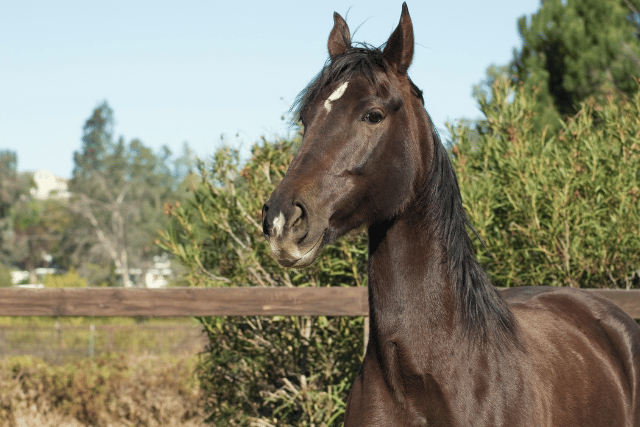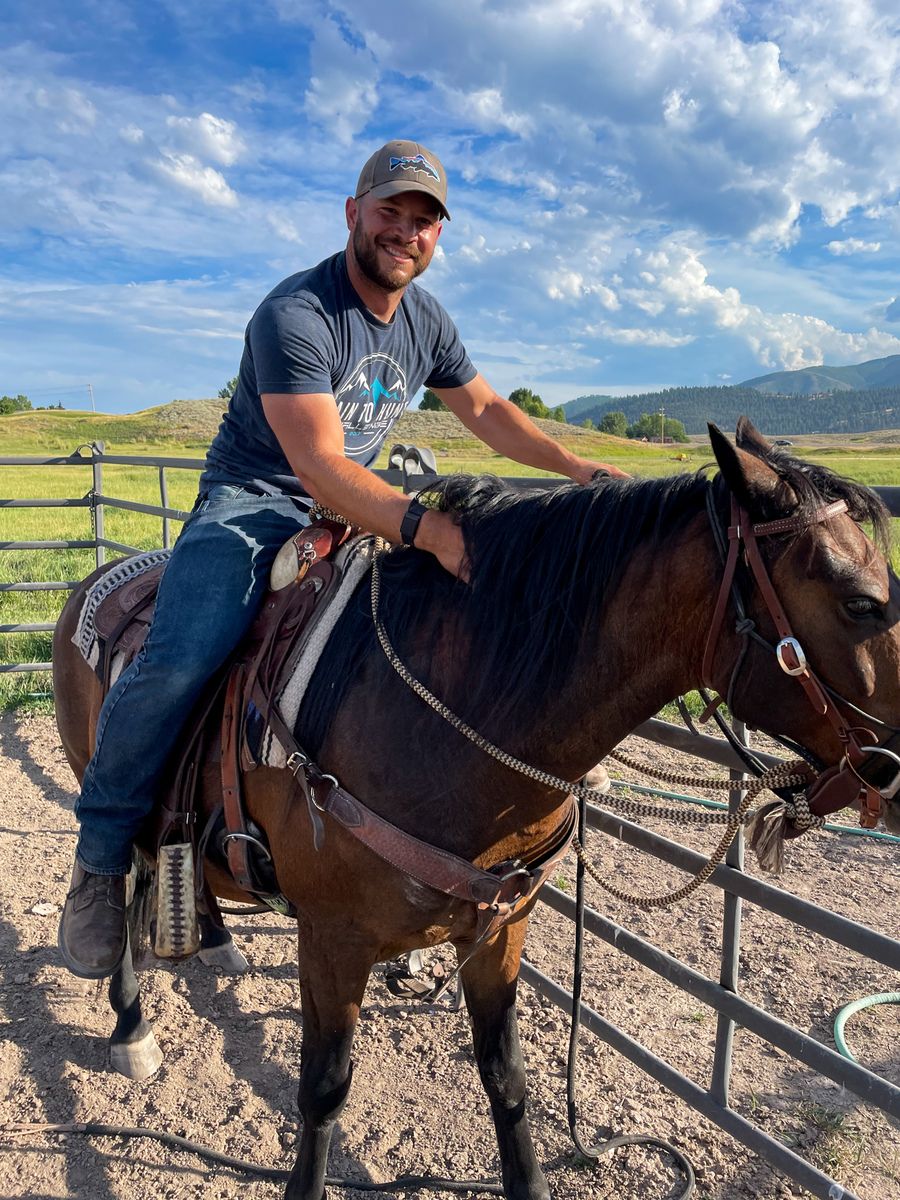
A warmblood horse bridges the gap between the spirited agility of hot-blooded breeds and the gentle giant nature of the cold-blooded drafts. Warmbloods encompass various breeds tailored for excellence, especially revered for their accomplishments in equestrian sports.
In this article, we’ll discuss “what is a warmblood horse,” dissect the nuances of what truly defines a warmblood, and its prominence in the horse-riding community.
Key Takeaways
Warmblood horses blend the best characteristics of hot-blooded and cold-blooded horses, possessing a temperament ideal for all rider levels and versatility for various equestrian disciplines.
Warmblood breeds have evolved from European crossbreeding between athletic, hot-blooded, and strong, cold-blooded horses to meet the demands of cavalry, agriculture, and now primarily equestrian sports.
Warmbloods, known for their proportional build and balanced temperament, are highly sought after in competitive equestrian sports such as dressage and show jumping, with top specimens commanding premium prices.
Defining A "Warmblood"

Horses have traditionally been classified into three groups based on their temperament and physiology.
Hot-blooded horses, such an Arabians, Thoroughbreds, or a quarter horse, are celebrated for their athleticism, intelligence, and sensitivity. They are ideal for confident riders requiring a sensitive and energetic equine partner.
On the other side of the spectrum are the cold-blooded horses. Known for their reliable temperament and kind nature, these horses are fantastic partners for more timid riders who ride for pleasure, especially when the external temperature is within a suitable temperature range, avoiding extreme temperatures.
Imagine having a horse that offers the best of both worlds.
This is where warmblood horses fit in.
While not all warm-blooded horses are classified as "warmblood breeds," they are highly regarded for having a temperament that harmoniously balances the characteristics of hot-blooded and cold-blooded horses.
Warmblood horses are distinguished from the Arabians in several ways, including their origin, size, build, temperament, use, and coat colors.
The Genesis of Warmblood Breeds
The journey of warmblood breeds started with European crossbreeding initiatives. These initiatives blended the athleticism and speed of hot-blooded horses with the strength and calm demeanor of the heavier native horses.
Over time, the breeding goals for warmbloods have adapted to meet varying demands.
From cavalry to agriculture to modern equestrian sports, warmbloods have evolved to excel in varied disciplines. Selective breeding strategies utilized foundation breeds such as Thoroughbreds and Arabians to achieve athletic ability and desired conformation.
Presently, equestrian sports become the focal point in selectively breeding warmbloods.
Characteristics of Warmblood Horses

Warmblood horses are recognized for:
Their well-proportioned physique
Their balanced temperament
Their medium body weight
Their athletic structure
These qualities make them versatile competitors in equestrian sports.
Physical Traits
Regarding physical attributes, warmbloods exhibit a blend of athleticism and robustness. These traits are a result of their ‘light’ riding breed and ‘heavy’ working breed origins.
They generally stand 15 to 17 hands high, showcasing a powerful build with a refined head and long, powerful legs, perfect for jumping.
Specifically, Dutch Warmbloods:
have a well-proportioned body
have a refined head
have expressive eyes
have muscular conformation
epitomize the elegance and strength of the warmblood breed
have well-angled shoulders
have strong hindquarters
have fluid and graceful movement
Temperament
Warmbloods have inherited the best traits from their ‘hot-blooded’ and ‘cold-blooded’ ancestors. They possess the agility and speed of their ‘hot-blooded’ lineage, as well as the calm disposition typical of ‘cold-blooded’ breeds. This combination makes warmbloods adaptable to various equestrian disciplines and suitable for both beginner and experienced riders.
These horses typically experience a lower heart rate response to spooky stimuli, enabling them to calm down quicker - a trait likely passed down from their ‘cold-blooded’ heritage. Their less reactive demeanor makes warmbloods an excellent choice for beginner or timid riders, much like the cob breeds renowned for their mild temperament.
The Spectrum of Warmblood Breeds

The label “warmblood” covers a broad range of breeds, each distinguished by its unique features and specialties. Some of these breeds include:
Hanoverian
Belgian Warmblood
Danish Warmblood
Selle Français
Trakehner
Holsteiner
Dutch Warmblood
Irish Sport Horse
Brandenburger
Swiss Warmblood
Oldenburg
Westphalian
Swedish Warmblood
Andalusian
Tennessee Walker
Appaloosa
These breeds have been selectively bred for specialties in dressage, show jumping, eventing, and other equestrian sports.
Common goals in breeding warmbloods include fostering:
a good character
a readiness to perform
a person-friendly disposition
Attributes like strength, agility, intelligence, and suitability as cooperative partners in competitive equestrian sports.
Dutch Warmblood horses, known for varied colors such as bay, chestnut, black, and gray, often feature distinctive white markings. This highlights the distinct appearance that can be found within warmblood breeds.
Warmbloods in the World of Equestrian Sports

Warmblood horses have firmly positioned themselves as the backbone of the sport horse industry. They have emerged as dominant forces in globally recognized equestrian competitions, including dressage, show jumping, and eventing. Their capabilities have been acknowledged and celebrated, with warmbloods symbolizing success within the equestrian sports industry. Consequently, top-quality specimens command high prices.
Historically, European warmbloods were specifically bred to excel in a variety of equestrian sports, reflecting their inherent versatility extending to:
Dressage
Show jumping
Eventing
Combined driving
Dutch Warmbloods and Bavarian Warmbloods are excellent examples, known for their specialized agility, grace, and competitiveness required for top-level equestrian sports disciplines.
Warmbloods vs Other Horse Types
In comparison to other horse types, warmbloods achieve an ideal balance.
Cold-blooded horse breeds like the Belgian Draft Horse are typically used for heavy work due to their calm and gentle disposition. On the other hand, hot-blooded horses like Arabians and Thoroughbreds display sensitivity and extra energy, requiring regular mental and physical stimulation.
Thoroughbreds are the most popular breed in the racing world. They are renowned for their athleticism and high energy, which they use to their advantage in competitive disciplines.
Selecting the Right Warmblood for You
Choosing the suitable warmblood requires careful consideration of several factors.
The rider’s experience level plays a crucial role in this selection. Beginners would benefit from calmer horses, while experienced riders would do well with horses that are responsive and agile.
The diverse breeds within the warmblood category, such as the Hanoverians known for their good temperament and athleticism, provide a preferred range of options suitable for both novice and experienced riders.
Assessing a warmblood horse’s behavior during handling can provide useful insights into its disposition, suggesting the level of ease in managing and riding the horse. The horse's age also influences its suitability for a rider; younger horses may require more training, whereas older horses might have health issues that must be considered.
Summary
We've finally come to the end of our exploration into the world of warmblood horses, their unique characteristics, their varied breeds, and their prominence in the world of equestrian sports. Combining the athleticism and sensitivity of hot-blooded horses with the calm and gentle temperament of cold-blooded horses, warmbloods stand as a testament to the beauty of selective breeding.
Whether you’re a beginner or an experienced rider, and depending on how to plan on using your horse, a warmblood breed may be the right choice for you.
Frequently Asked Questions
What makes a warmblood horse a warmblood?
A warmblood horse is a mix of hot- and cold-blooded horses, creating a sport horse known for its versatility and athleticism. This breed is the result of combining heavy, cold-blood draft horses with lighter hotbloods like Arabians and Thoroughbreds.
How did warmblood breeds originate?
Warmblood breeds originated from European crossbreeding programs, combining hot-blooded horses with heavier native horses to create a versatile, athletic type of horse.
What are the physical traits of warmblood horses?
Warmblood horses exhibit a blend of athleticism and sturdiness. They stand 15 to 17 hands high and possess a powerful build, refined head, and long, strong legs.
How do warmblood horses perform in equestrian sports?
Warmblood horses excel in equestrian sports such as dressage, show jumping, and eventing, making them a dominant force in the sport horse industry.
How do I select the right warmblood horse for me?
To find a suitable warmblood horse for you, consider factors such as your experience level, the horse's temperament, age, and level of training. These factors are crucial in determining the right fit for both you and the horse.
